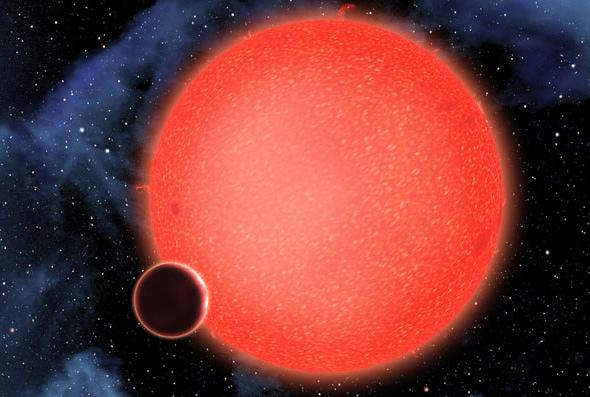Two independent teams of astronomers have just announced the discovery of an unusual planet with a grim future: Kepler-432b.
The planet orbits a star nearly 3,000 light-years away and was discovered using the Kepler observatory, which looks for telltale dips in star light as a planet orbits a star; if the planet’s orbit is seen edge-on from Earth, then once per orbit it blocks a small fraction of the star when it passes directly between the star and Earth.
Measuring the timing of the dip (and knowing some of the properties of the star) yields a lot of information about the planet, including its size, and the size and shape of its orbit. They also took spectra of the star, breaking its light up into thousands of individual colors, which yields one more crucial piece of information: the mass of the planet. The planet and star orbit a common center of gravity, and as the star moves in its orbit its spectrum changes due to the Doppler shift. This effect is pretty dang small, but measurable using precision instruments.
The results are pretty cool: The planet Kepler-432b is roughly five times more massive than Jupiter, but only about 1.1 times as wide. This makes it pretty dense, about as dense as Earth! Gas giants have a weird property that as they get more massive their size doesn’t increase much—instead, the pressure inside them increases, and their density goes way up. Jupiter is right at about the lower limit where that happens, so planets can be much beefier than Jupiter but not much bigger.
But what makes this system special is the star itself. It’s a little more massive than the Sun, but it’s what we call a red giant: A star that is starting to die.
At some point in the past, the star Kepler-432 ran out of hydrogen fuel in its core. The core of the star is shrinking and heating up, dumping all that heat into its outer layers. What happens to a gas when you heat it up? It expands. And so Kepler-432 has swollen up to a size about four times wider than our Sun. As it got bigger its surface area increased, too, and so, weirdly, the amount of energy coming through its surface per square centimeter has actually dropped, lowering its temperature. Cooler stars are red, so Kepler-432 is a red giant.
It will continue to grow as it ages, swelling to a much larger size than it is now. Much larger. Will it engulf the planet?
It may not grow enough to swallow the planet directly. However, as it gets bigger, it interacts with the planet via tides, and (through a complicated series of steps) will actually drop the planet closer in to the star.
It looks like this one-two punch is enough to doom the planet. The star will grow larger, the planet’s orbit will shrink, and then … doom. The planet will fall into the star, where it will plunge deeper and deeper, until it evaporates completely.
But don’t despair too much. As the planet falls inside the star, it takes a while to disintegrate. It orbits much faster than the star spins, so it may churn up the insides of the star like a whisk in a mixing bowl of batter. The star’s rotation will increase. As the star continues to age, it will fling off its outer layers, exposing the hot core at its center. This very dense, very hot object, now called a white dwarf, will blast ultraviolet light into space, illuminating and exciting the gas it ejected, causing it to glow. Because the star was spinning, this gas can take on fantastic shapes, including double-lobed patterns reminiscent of butterfly wings.

Photo by ESA/Hubble & NASA
Scientifically, this system is fascinating; we don’t have too many examples of giant planets orbiting red giant stars (which may be in part due to the fact that they tend to fall into their stars!), so every one we find is important. The planet orbits the star on a long ellipse, too, which is unusual and difficult to explain. There are many mysteries to plumb here.
And metaphorically, well, this transformation is almost too on-the-nose: Like a caterpillar, the planet and star will transform into something magnificent, literally a butterfly shape. And it will glow fiercely like that for centuries, its beauty visible easily from telescopes even thousands of light years away.
The Universe is all about change, birth, destruction … and given that, perhaps Kepler-432b’s eventual fate isn’t such a bad one.
Postscript: You can read the papers published by the two teams who studied this planet: Ciceri et al., and Ortiz et al. Their results match pretty well, though, interestingly, Ciceri et al. find no evidence for a second planet orbiting the star, while Ortiz et al. do. Also, Ciceri et al. conclude the planet won’t be engulfed. I don’t think they included the work showing the planet’s orbital radius will shrink, though, which was considered by Ortiz et al., so I tend to agree with Ortiz’s team. The planet is doomed.
